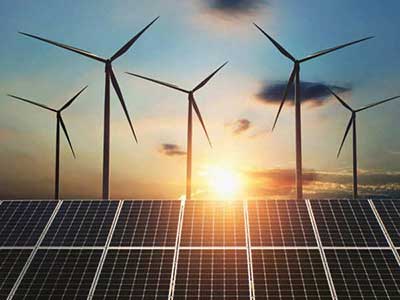Date: 29/03/2023
Relevance: GS-3: Science and Technology- developments and their applications and effects in everyday life: Conservation, environmental pollution and degradation, environmental impact assessment.
Key Phrases: Renewable Energy, Solar Power Projects, INDCs, Carbon Emissions, Irradiation Potential Sites, Solar Parks, Incentivisation, Subsidies, Solar Rooftop.
Context:
- A significant share of the solar power projects currently under implementation in India is located in the states of Rajasthan and Gujarat.
Key Highlights:
- According to industry analysts, the choice of these states as preferred locations for solar projects is influenced by a combination of factors, including the efforts of the respective state governments and the availability of sites with high potential for energy generation.
- As of February 2023, India has installed a cumulative solar power capacity of 64.38 GW, with an additional 52 GW capacity in solar projects currently being implemented.
- Out of the 52 GW under execution, Rajasthan is responsible for implementing 23 GW of capacity that is anticipated to be commissioned from March 2023 to November 2026, according to the data presented by Union New and Renewable Energy Minister.
The Solar Potential of Rajasthan:
- Rajasthan has been at the forefront of solar capacity additions
in recent years owing to the presence of sites with higher irradiation
potential.
- The state experiences a substantial number of sunshine days every year, providing ideal conditions for solar power generation.
- Furthermore, the availability of vast tracts of contiguous, non-agricultural land facilitates the development of larger projects at a single site, allowing for economies of scale.
- The efforts of the state and central governments, such as providing transmission infrastructure and establishing solar parks within Rajasthan, have also contributed to the rapid expansion of solar capacity in the region.
- Out of the 52 GW of solar capacity under construction, Gujarat is
currently building nearly 8 GW of capacity, expected to be commissioned in
the coming years.
- Maharashtra is implementing close to 4 GW of capacity, while Andhra Pradesh, Madhya Pradesh, and Karnataka are implementing projects in the range of 2.1-2.6 GW capacity.
- Rajasthan is the leader in renewable power, boasting a total installed capacity of 21,237 MW, including 16,406 MW of solar capacity (comprising ground-mounted, rooftop, hybrid solar, and off-grid categories) - the highest among all Indian states.
National Solar Mission
- National Institute of Solar Energy has assessed the Country’s solar potential of about 748 GW assuming 3% of the waste land area to be covered by Solar PV modules.
- Solar energy has taken a central place in India's National Action Plan on Climate Change with National Solar Mission as one of the key Missions. National Solar Mission (NSM) was launched on 11th January, 2010.
- NSM is a major initiative of the Government of India with
active participation from States to promote ecological sustainable
growth while addressing India’s energy security challenges.
- It will also constitute a major contribution by India to the global effort to meet the challenges of climate change.
- The Mission’s objective is to establish India as a global leader in solar energy by creating the policy conditions for solar technology diffusion across the country as quickly as possible.
- The Mission targets installing 100 GW grid-connected solar power plants by the year 2022. This is in line with India’s Intended Nationally Determined Contributions(INDCs) target to achieve about 40 percent cumulative electric power installed capacity from non-fossil fuel based energy resources and to reduce the emission intensity of its GDP by 33 to 35 percent from 2005 level by 2030.
Gujarat, a Solar Paradise:
- Gujarat is emerging as a solar paradise in India due to its
conducive environment for solar power generation.
- The state has a total renewable capacity of 19,016 MW, including 8,888 MW of solar capacity, which makes it the second-highest solar power capacity holder in India.
- Factors that make Gujarat a solar paradise include an adequate supply of vendors, increasing demand through incentivization, digitization, and timely disbursal of subsidies.
- Moreover, prompt subsidy dissemination gives a major impetus for
end-consumers in Gujarat to opt for solar rooftop installations proactively.
- As per JMK Research, about 65% of all residential solar rooftop installations in FY2023 will be in Gujarat.
Conclusion:
- Rajasthan and Gujarat are leading the way in solar power projects under
implementation in India.
- Rajasthan has a higher potential for solar power generation due to its high irradiation potential sites, and government efforts, including the provision of transmission infrastructure and solar parks, have contributed to the faster growth of solar capacity in the state.
- On the other hand, Gujarat's favourable environment for solar power generation, including adequate supply of vendors, incentivization, and prompt subsidy dissemination, is making it a solar paradise.
- The future of solar power in India looks promising, with both Rajasthan and Gujarat expected to continue to enjoy a higher share in solar capacity additions over the medium term, and the government's focus on renewable energy and incentives to the industry likely to increase the growth of the solar power sector in India.
Source: The Hindu BL
Mains Question:
Q. Describe the key factors influencing the choice of Rajasthan and Gujarat as preferred locations for solar power projects in India. How have these factors contributed to the faster growth of solar capacity in these states? (250 words).






















